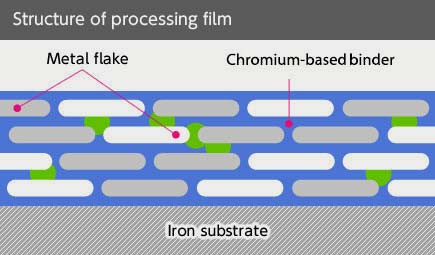Dacromet

dacromet® 320
DACROMET® 320 is a non-electrolytic water-based thin-film coating for the corrosion protection of articles made from steel, cast iron, or other iron metals. The coating contains zinc and aluminium flakes in a chromium binder. The coating is metallic silver in appearance. DACROTIZING is the process whereby the aqueous dispersion is applied by cold immersion or spray and is therefore free of any risk of hydrogen embrittlement. The coating thus produced is passivated throughout the film and provides high performance corrosion protection.
CHARACTERISTICS:
The corrosion resistance of DACROMET® 320 depends upon the thickness of the coating and is due to the combination of several mechanisms:
A barrier effect due to the tile-like structure of the film.
- Salt Spray Test (ISO 9227)
- 240 hours without white rust
- 600 hours without red rust
Controlled sacrificial protection of the zinc in relation to the metal substrate.
The film passivation which reduces the speed at which the zinc and aluminium are consumed.
dacromet® 500
DACROMET® 500 is a non-electrolytic water-based thin-film coating for the corrosion protection of articles made from steel, cast iron, or other iron metals. The coating contains zinc and aluminium flakes in a chromium binder. The coating is metallic silver in appearance. DACROTIZING is the process whereby the aqueous dispersion is applied by cold immersion or spray and is therefore free of any risk of hydrogen embrittlement. The coating thus produced is passivated throughout the film and provides high performance corrosion protection.
CHARACTERISTICS:
The corrosion resistance of DACROMET® 500 depends upon the thickness of the coating and is due to the combination of several mechanisms:
A barrier effect due to the tile-like structure of the film.
- Salt Spray Test (ISO 9227)
- 240 hours without white rust
- 600 hours without red rust
Controlled sacrificial protection of the zinc in relation to the metal substrate.
The film passivation which reduces the speed at which the zinc and aluminium are consumed.
Provides a controlled coefficient of friction on nuts and screws i.e. u average between 0.12- 0.18.
